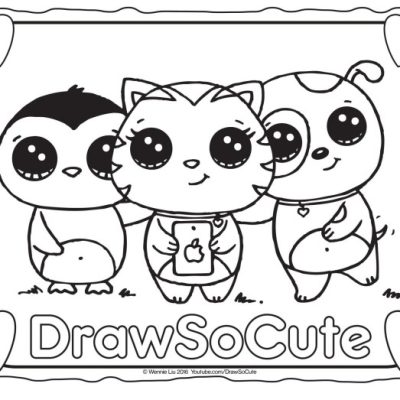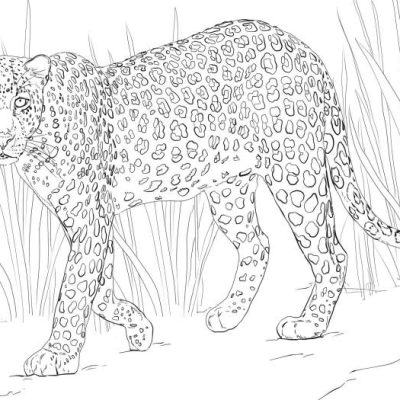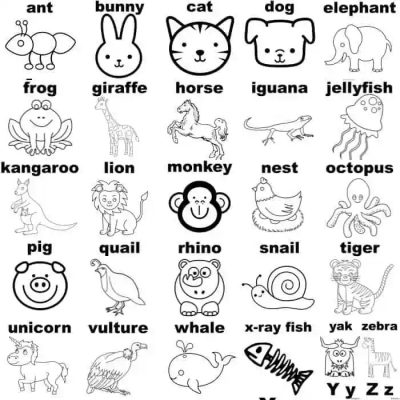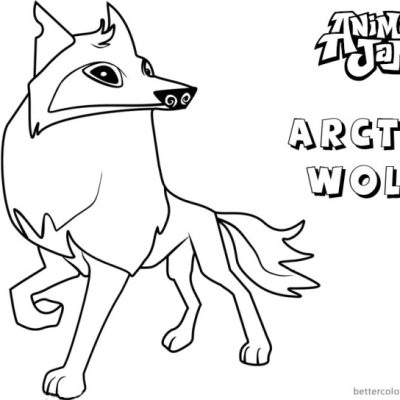Cute Animal Coloring Sheets Printable Fun for All!

Design Elements of Effective Coloring Sheets
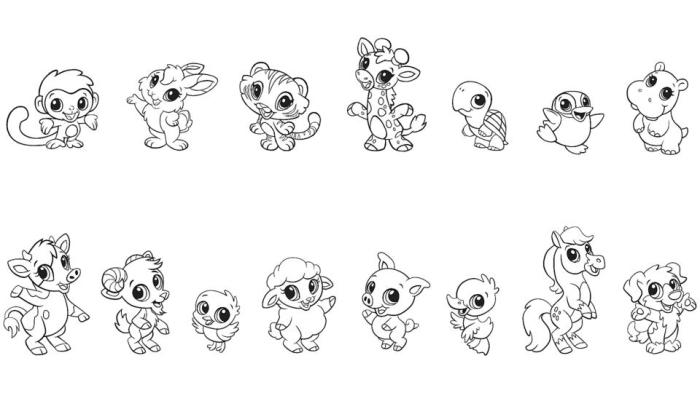
Cute animal coloring sheets printable – Creating irresistibly cute and engaging coloring sheets requires a thoughtful approach to design. The right combination of elements can transform a simple Artikel into a captivating creative experience for children (and adults!). Let’s delve into the key aspects that contribute to a truly appealing coloring page.
Color Palettes and Cuteness
The choice of color palette significantly impacts the overall “cuteness” factor. Pastel shades, soft and muted tones, evoke a sense of gentleness and playfulness, perfectly complementing adorable animal subjects. Think soft pinks, baby blues, and creamy yellows. Conversely, brighter, more saturated colors can create a vibrant and energetic feel, suitable for more playful or mischievous animal designs.
Using analogous colors (colors next to each other on the color wheel) creates a harmonious and soothing effect, while complementary colors (opposite each other on the color wheel) can add visual interest and excitement. For example, a pastel pink and light blue palette would be perfect for a sweet bunny rabbit, while a combination of sunny yellow and bright orange could bring to life a playful monkey.
Line Thickness and Complexity
Line thickness and the overall complexity of the design directly influence the user experience. Thicker lines are generally easier for younger children to color within, reducing frustration and enhancing their enjoyment. Simpler designs with fewer intricate details are ideal for beginners, allowing them to focus on coloring and developing their fine motor skills. More complex designs with thinner lines and detailed features are better suited for older children or adults who enjoy a more challenging coloring experience.
For instance, a simple Artikel of a kitten with large, easily colored shapes would be perfect for a toddler, while a detailed illustration of a panda with intricate fur details would appeal to older children or adults.
Design Styles: Examples
The style of the coloring sheet significantly impacts its appeal. Here are some examples:
- Simple: A simple design features bold Artikels, large, easily colored shapes, and minimal detail. Imagine a large, round-bellied puppy with oversized ears and a simple tail. The focus is on ease of coloring and immediate visual appeal.
- Detailed: Detailed designs incorporate intricate linework, fine details, and textures. Think of a fluffy kitten with meticulously rendered fur, individual whiskers, and delicately drawn paws. This style challenges the colorer and allows for a more nuanced finished product.
- Whimsical: Whimsical designs incorporate playful elements, exaggerated features, and unusual combinations. Picture a cheerful hedgehog wearing a tiny hat and carrying a miniature umbrella. The focus is on creating a fun and imaginative experience.
Printable Format Considerations
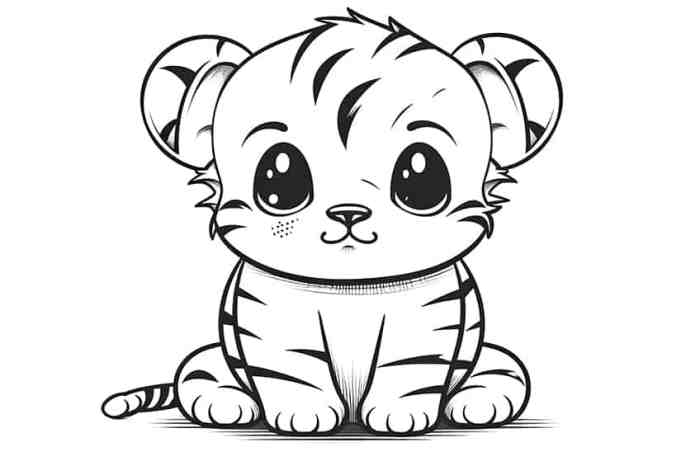
Getting your adorable animal coloring sheets ready for printing involves more than just a pretty picture! Choosing the right file format, optimizing the file size, and considering page layout are crucial steps to ensure a smooth and enjoyable printing experience for everyone. Let’s dive into the details to make sure your creations are perfectly printable.Preparing your coloring sheets for printing requires careful consideration of several factors to guarantee high-quality, easily printable files.
This section will guide you through the best practices for file formats, optimization, and page layout to ensure your delightful designs translate seamlessly from screen to paper.
Recommended File Formats
Choosing the right file format is paramount for preserving image quality and ensuring compatibility across various printers and devices. PDF and JPG are excellent choices for printable coloring sheets, each with its own advantages. PDF files maintain vector graphics and text integrity, ensuring sharp lines and crisp details even after multiple prints or zoom adjustments. JPG files, on the other hand, are widely compatible and generally result in smaller file sizes, which can be beneficial for faster downloads and printing.
Optimizing File Size Without Compromising Image Quality
Large file sizes can lead to slow downloads and printing difficulties. Optimizing your files without sacrificing image quality is key. For JPGs, using a suitable compression level is crucial. Experiment to find the balance between file size and image quality – a slight reduction in quality is often imperceptible but significantly reduces file size. For PDFs, consider flattening layers and embedding fonts to reduce the file size while maintaining the integrity of the design.
Tools like Adobe Acrobat Pro offer features to optimize PDF files for print.
Importance of Page Layout and Margins
Careful page layout and appropriate margins are essential for creating professional-looking and easily printable coloring sheets. Sufficient margins (at least 0.5 inches on all sides) prevent important parts of the design from being cut off during printing. Consider the size of the paper you intend to use and arrange the coloring pages accordingly. Multiple smaller designs per page can save paper and ink, while larger designs might require a single page per design.
Consistent spacing between designs, if multiple are on a page, enhances the overall aesthetic appeal.
Sample Printable Sheet Layouts, Cute animal coloring sheets printable
The table below illustrates different layouts for your coloring sheets, demonstrating how to effectively arrange multiple designs on a single page. Remember to adjust the number of columns based on your design size and paper dimensions.
| Layout 1 (Single Large Design) | Layout 2 (Two Columns) | Layout 3 (Three Columns) | Layout 4 (Four Columns) |
|---|---|---|---|
|
A single, large coloring page filling the entire page, suitable for larger, more detailed designs. Consider using a larger paper size for optimal results. |
Two equally sized coloring pages arranged side-by-side, ideal for a balance between design size and paper efficiency. This is great for a variety of smaller animal designs. |
Three equally sized coloring pages arranged in a row, suitable for smaller designs or a combination of larger and smaller ones. This layout maximizes paper usage while still allowing for decent-sized designs. Cute animal coloring sheets printable offer a fun, accessible creative outlet for all ages. For a more intricate design, consider exploring the detailed patterns found in mandala animal coloring pages ; their complexity offers a different creative challenge. Returning to simpler designs, cute animal coloring sheets remain a popular choice for their ease of use and charming subjects. |
Four equally sized coloring pages arranged in a grid, maximizing the number of designs per page, best suited for very small and simple designs. This option saves paper but might lead to smaller designs. |
Animal Choices and Their Representation

Choosing the right animals for a coloring sheet is crucial. The goal is to create images that are both appealing to children and ethically sound. The inherent “cuteness” of an animal plays a significant role in its selection, as does the ease with which its features can be translated into a simple, yet engaging, coloring page design.Animals are often considered “cute” due to a combination of factors, including neotenous features (characteristics that persist from infancy into adulthood), such as large eyes, small noses, and round faces.
These features trigger a nurturing response in humans, leading to feelings of affection and a desire to protect. Other contributing factors include soft fur or feathers, playful behavior, and generally non-threatening demeanors. These factors all contribute to the overall aesthetic appeal and suitability for a coloring sheet aimed at a younger audience.
Visual Representation of Different Animals
Puppies, kittens, and pandas offer excellent examples of animals with varying visual characteristics that translate well into coloring pages. Puppies, with their floppy ears and expressive eyes, lend themselves to simple, yet charming designs. Their diverse breeds allow for a range of shapes and sizes, offering creative flexibility. Kittens, similarly, possess endearing features such as tiny paws and playful postures, easily adaptable to a coloring sheet format.
Pandas, with their iconic black and white markings and generally placid demeanor, provide a striking visual contrast, making them immediately recognizable and appealing to color. The contrast between their black and white fur allows for simple yet impactful coloring. However, while these animals are generally considered cute, it’s important to avoid overly simplistic or stereotypical representations.
Ethical Considerations in Animal Depiction
Ethical considerations are paramount when depicting animals in coloring sheets. It’s crucial to avoid perpetuating stereotypes or misrepresenting animal behavior. For example, depicting a wild animal, such as a lion, in a docile or overly friendly manner could mislead children about its natural behavior and potentially create a false sense of security. Similarly, avoiding exaggerated or unrealistic features is important; the goal is to present an accurate, albeit simplified, representation of the animal.
Focusing on the animal’s natural beauty and avoiding anthropomorphism (giving human characteristics to animals) is key to ethical representation.
Five Unique Animals Suitable for Coloring Sheets
Several animals offer unique visual appeal and are suitable for coloring sheets. The selection emphasizes a balance of recognizable features, simplified forms, and interesting textures.
- Red Pandas: Their reddish-brown fur, bushy tails, and charmingly inquisitive faces provide a visually rich and engaging subject. The color palette is relatively simple, making them easy to color for younger children. Their unique appearance also makes them less likely to be confused with other animals.
- Hedgehogs: The spiky exterior and compact body of a hedgehog are easily represented in a coloring sheet format. The contrast between the spines and the underbelly provides a simple yet effective design. The relatively simple shape allows for a clear and easily colored image.
- Slow Lorises: These nocturnal primates, with their large, expressive eyes and slow, deliberate movements, offer a unique and appealing visual. Their gentle nature and distinctive features make them ideal for a coloring sheet, provided the depiction accurately reflects their actual appearance.
- Capybaras: These large semi-aquatic rodents are known for their relaxed demeanor and friendly nature. Their smooth fur and gentle features provide a simple yet pleasing coloring subject. The lack of intricate details makes them easily accessible for children of all ages.
- Arctic Foxes: The thick, white fur of the Arctic fox, combined with its small, triangular ears and bushy tail, creates a striking visual. The simple color scheme (primarily white) makes coloring accessible while the features are distinct and memorable.
Marketing and Distribution Strategies
Successfully launching your adorable animal coloring sheets requires a smart marketing and distribution plan. Reaching your target audience – parents, teachers, and crafty individuals – depends on leveraging the right online channels and crafting compelling messaging that highlights the unique charm of your designs.Effective methods for marketing printable coloring sheets online involve a multi-pronged approach combining organic reach with targeted advertising.
Organic strategies include creating engaging social media content showcasing the coloring pages, interacting with relevant online communities, and optimizing your website for search engines. Paid advertising, such as targeted Facebook or Instagram ads, can significantly boost visibility, allowing you to reach specific demographics interested in printable activities for children. Utilizing email marketing to nurture leads and promote new releases is also crucial.
Potential Platforms for Distribution
Choosing the right platforms for distribution is key to maximizing reach. A dedicated website acts as your central hub, offering a user-friendly experience for browsing and purchasing your coloring sheets. Social media platforms like Pinterest, Instagram, and Facebook provide visual channels to showcase your designs and engage with potential customers. Etsy and similar online marketplaces offer established audiences interested in printable crafts and digital downloads.
Consider partnering with relevant blogs or websites focused on parenting, crafts, or education to expand your reach further.
Creating a Visually Appealing Online Store
Your online store should be visually appealing and easy to navigate. High-quality images of your coloring sheets are essential. Use a clean and simple design that highlights the cuteness of the animals. Organize your sheets into clear categories (e.g., farm animals, jungle animals, ocean animals). A clear and concise checkout process is vital for converting browsers into buyers.
Consider offering different pricing tiers, such as single sheets or bundles, to cater to various budgets. Customer reviews and testimonials add social proof and build trust. A visually appealing store with intuitive navigation and a streamlined checkout process is essential for creating a positive customer experience and driving sales.
Using Compelling Descriptions to Attract Customers
Compelling descriptions are crucial for attracting customers. Instead of simply listing features, focus on the benefits. For example, instead of saying “Printable coloring sheet of a cute panda,” try “Unleash your child’s creativity with our adorable panda coloring sheet! Perfect for quiet time, rainy days, or a fun family activity. High-resolution printable PDF ensures vibrant colors and crisp lines.” Highlight the unique qualities of each sheet, such as intricate details or charming character expressions.
Use s relevant to your target audience’s searches (e.g., “printable coloring pages for kids,” “animal coloring sheets,” “toddler activities”). Emphasize the quality and value of your product, highlighting the benefits of choosing your sheets over competitors. A well-written description will entice potential customers to purchase your coloring sheets.
Illustrative Examples: Cute Animal Coloring Sheets Printable
Let’s dive into the whimsical world of cute animal coloring sheets with three distinct examples, showcasing diverse styles and target audiences. Each design emphasizes visual elements that contribute to an irresistible level of adorableness, ensuring hours of creative fun for young artists.
The following examples demonstrate how different animal choices, artistic styles, and color palettes can create unique and engaging coloring page experiences. We’ll explore the specific elements that make each design appealing and consider the ideal age range for each.
Example 1: Playful Panda Picnic
This coloring sheet features a chubby panda bear enjoying a picnic amidst a vibrant bamboo forest.
- Animal Choice: Panda. Pandas are universally loved for their cuddly appearance and gentle nature. Their black and white coloring provides a great starting point for creative exploration.
- Style: Cartoonish and simplistic. The panda is depicted in a slightly exaggerated, cartoonish style, with large, expressive eyes and a round, cuddly body. The lines are simple and bold, making it easy for young children to color within the lines.
- Color Palette: Primarily black, white, and shades of green for the bamboo. Additional pops of color can be added to the picnic basket, such as bright yellows, reds, and oranges for fruits and other treats. This allows for creative freedom while maintaining the overall cuteness.
- Visual Elements Contributing to Cuteness: The panda’s large, innocent eyes, its plump cheeks, and the overall playful scene of a picnic in a beautiful bamboo forest all contribute to its charm. The simplicity of the design makes it accessible and appealing to a younger audience.
- Target Audience: Preschoolers (ages 3-5) and early elementary school children (ages 6-8).
Example 2: Sophisticated Squirrel in a Teacup
This coloring sheet presents a more detailed and intricate design, ideal for older children who enjoy more challenging coloring projects.
- Animal Choice: Squirrel. Squirrels, with their bushy tails and nimble movements, offer a charming subject for a more detailed illustration.
- Style: Realistic with stylized elements. While aiming for a realistic portrayal of a squirrel, the design incorporates stylistic choices such as a whimsical teacup setting and slightly exaggerated features to maintain a cute aesthetic. The lines are finer and more detailed than in the panda example.
- Color Palette: A warm, earthy palette. Think browns, creams, and reds for the squirrel and its surroundings, with pops of brighter colors for the teacup and any accompanying flowers or foliage. This sophisticated palette allows for nuanced coloring and shading.
- Visual Elements Contributing to Cuteness: The squirrel’s pose – perhaps perched delicately on the rim of a teacup – adds to its charm. The detail in the fur and the overall setting creates a sense of whimsy and sophistication.
- Target Audience: Older elementary school children (ages 9-12) and pre-teens.
Example 3: Sleepy Sloth Hanging Out
This coloring sheet features a sloth in a relaxed and endearing pose.
- Animal Choice: Sloth. Sloths are known for their slow and relaxed movements, which immediately convey a sense of calm and cuteness.
- Style: Simplified realism. The sloth is depicted in a relatively realistic style, but with simplified details to make it easy to color. The focus is on capturing the sloth’s inherently adorable features.
- Color Palette: Muted greens, browns, and creams. These colors reflect the sloth’s natural habitat and contribute to a peaceful and calming overall feel. The use of muted tones allows for more subtle shading and highlights.
- Visual Elements Contributing to Cuteness: The sloth’s sleepy expression, its cuddly appearance, and its relaxed posture all contribute to its overall adorableness. The simple background allows the sloth to be the clear focal point.
- Target Audience: A wide range, appealing to children of all ages, from preschoolers to tweens, due to its simple design and universally loved animal choice.


